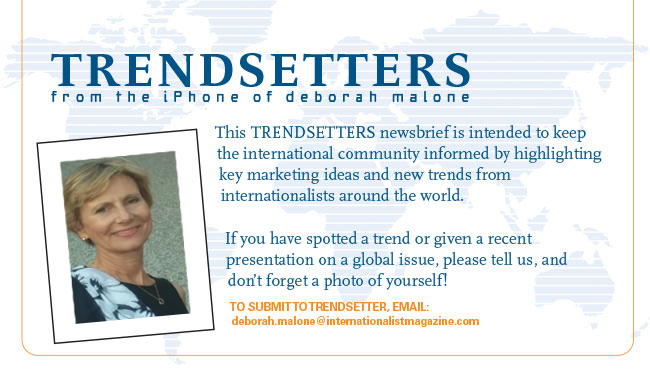

Esther Uhalte
See the current issue
of The Internationalist magazine
Find out how to sponsor an issue of Trendsetters
Trendsetters: Estee Lauder's Esther Uhalte Discusses How Global Media Strategy is Changing for Luxury Brands
Esther Uhalte is Executive Director of Global Media for the flagship Estee Lauder brand and is responsible for helping drive media strategy, effectiveness and efficiency in top markets around the world, in collaboration with the regional and local teams. "In a nutshell," she says, "my role is to help our local marketing teams make smarter media investments." Again, she emphasizes, "smarter media investments, not necessarily more investments."
As a result, she's noticing significant changes in global digital media trends, and those shifts are affecting the Estee Lauder brand's approach to media and marketing throughout the world, as well as considerations for targeting, call-to-action strategies, qualitative investments—all with an eye to retail collaboration and product sales.
In many ways, Esther has the perfect international background for her global role. Born and raised in Pamplona, Spain, she has lived and worked in Spain, Germany, France, and the US. She's one of the few executives to have experience within media, agency and marketer roles. Esther holds a Bachelor's degree in Advertising and Public Relations from the University of Navarra, Spain; a Masters in Marketing from the Sorbonne Graduate Business School in Paris; and a Professional Certificate in Digital Marketing from NYU. Spanish may be her mother tongue, but she is also bilingual in German, French, and English, and for the last 15 years has consistently alternated reading a book in each of her four languages during her commute.
She explains that the Estee Lauder brand spans the luxury skincare, skincare, makeup and fragrance categories. "This is a competitive advantage for the brand, but it adds complexity to the media strategy when other brands tend to operate in just one or two categories— enabling their consumer messages to be more streamlined." Given their breadth of products, the Estee Lauder brand has more messages with greater variation to communicate, while it strategically allocates media resources by category.
Esther acknowledges that media for the beauty industry has been traditionally focused on raising awareness of new launches, elevating the brand profile and maintaining brand equity. "Today," she says, "these factors remain important, but media must now deliver so much more—especially prompting the consumer to action. As part of an important call-to-action strategy, media must support and link to our retailer channels, as well as our own e-commerce and m-commerce sites."
According to Esther, this requires clear objectives and ruthless prioritization. She emphasizes, "Media cannot do everything at once, so we need to prioritize, and then choose the media placement and call-to-action for each ad, accordingly."
She adds that media targeting is a very delicate exercise for luxury brands. "On one end, there is the need to be surgical, to reach the highest prospects for growth and also to continue to engage with current consumers; on the other end, you want to invite enough new people to join the brand, so you can keep on recruiting and growing the business. You need a certain level of awareness for both your brand and your products, because you know you are going to lose a significant percentage of potential consumers as you move down the funnel from awareness towards familiarity, then purchase intent, then loyalty/advocacy."
Media innovation is, of course, very important to all brands. However, Esther believes that innovation must always add value to the consumer experience, and not be simply innovation for the mere sake of innovating. "It must make sense for the brand and our consumer. We strive to do things first, but above all, we strive to do things right."
She confesses, "Some marketers don't look much beyond the quantitative aspect of digital media. They focus more on ‘how much do you spend in digital' or ‘how much is your digital spend growing YOY.' It is a matter of qualitative investment as well. We have markets where our digital spend is growing rapidly year-on-year. Then, we also have markets where the spend is growing less rapidly but we are highly committed to improving quality, that is using less block-able, more engaging formats. Again, quantity and quality."
She believes that every media investment today comes with an additional consideration: How will a paid media effort contribute to generate earned media? The media ecosystem is broader than ever, and barriers are becoming less precise with the surge of native advertising and greater experimentation with content. Close collaboration between marketing, PR/global communications, creative services, and analytics teams is crucial to success.
Esther advocates in the media industry for more holistic thinking across all marketing levers. She explains: "An ad page may be considered a media expenditure, but if it has a call-to-action to redeem a sample online, then that spend is contributing to drive e-commerce. An in-store event enabling consumer data capture supports future CRM & Loyalty efforts. The distinction between budget ‘buckets' is quite blurred, and we should try as marketers to be more agile and flexible, to make truly holistic decisions for resource allocation across all consumer touch points."

